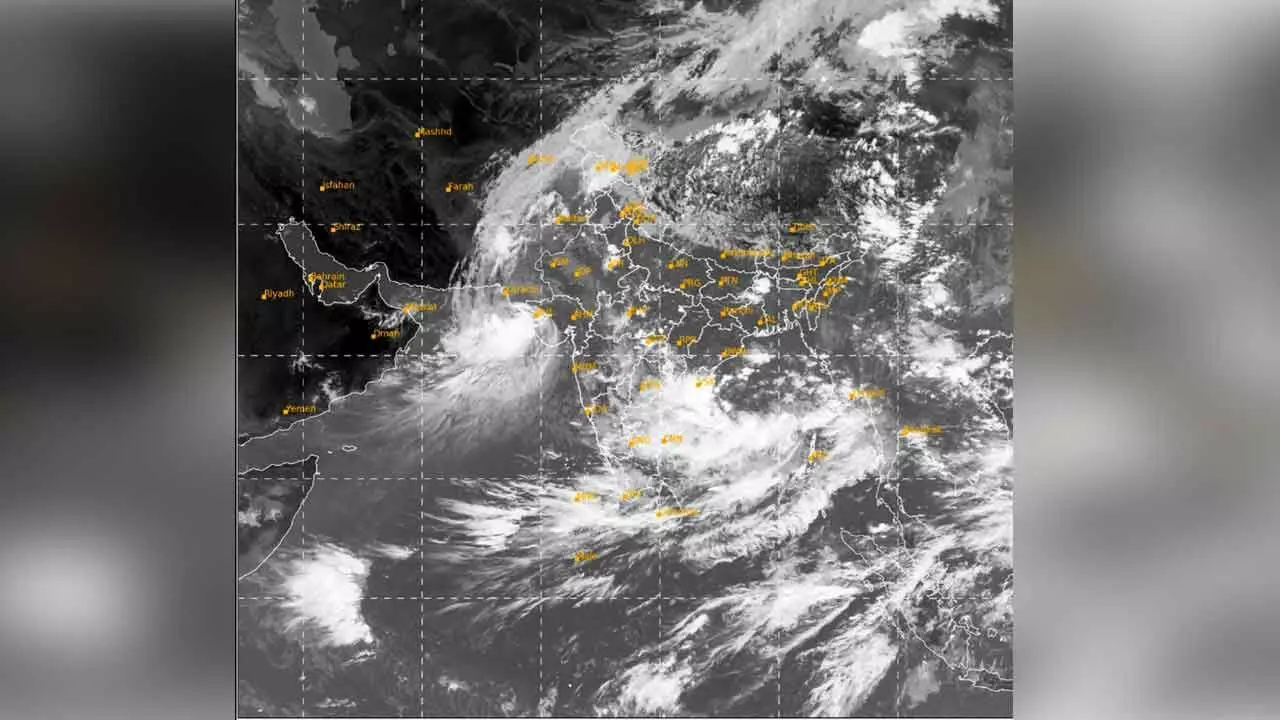Live
- Theft Case of Thumbe Mahalingeshwara Temple
- DIY vs professional car detailing: Pros and Cons
- Wild Elephant Gets Stuck at Rail Track Fence Forest Department Frees Animal
- CERT-In Issues Critical Security Alert for Apple Users: Update Your Devices Now
- Kolar’s Compassionate Leap: Mechanical Elephant Leads Temple Procession
- Centre to unveil startups under new National Quantum Mission guidelines
- Women’s protest rally in Imphal against re-imposition of AFSPA in 6 police station areas
- Greater Nicobar Island project has all environmental clearances: Govt
- Fadnavis leaves for Delhi, expected to meet Amit Shah along with Shinde, Ajit Pawar
- HYDRA-Relocated Residents Struggling with Severe Maintenance Issues at New Dignity Housing Colony
Just In
First cyclonic storm in Arabian Sea since 1976; named Cyclone Asna by Pak


New Delhi: A deep depression that triggered torrential rains and floods in Gujarat on Friday intensified into cyclone Asna off the coast of Kachchh...
New Delhi: A deep depression that triggered torrential rains and floods in Gujarat on Friday intensified into cyclone Asna off the coast of Kachchh and the adjoining areas of Pakistan, the India Meteorological Department (IMD) said. This is the first cyclonic storm in the Arabian Sea in August since 1976. The name Asna has been given by Pakistan.
Between 1891 and 2023, only three cyclonic storms formed in the Arabian Sea during August (in 1976, 1964, and 1944), according to the IMD. The 1976 cyclone originated over Odisha, moved west-northwestward, entered the Arabian Sea, followed a looping track, and weakened over the northwest Arabian Sea near the Oman coast.
The 1944 cyclone intensified after emerging into the Arabian Sea before weakening. In 1964, another short-lived cyclone developed near the South Gujarat coast and weakened near the coast. The deep depression over Kachchh coast and adjoining areas of Pakistan and Northeast Arabian Sea moved westward with a speed of 6 kmph during the past 6 hours, intensified into cyclonic storm 'Asna' (pronounced as As-Na) and lay centered at 1130 hours over the same region, 190 km west-northwest of Bhuj (Gujarat). It will continue moving nearly west-northwestwards over the northeast Arabian Sea, away from the Indian coast, over the next two days, the weather department said.
A deep depression is a low-pressure system with wind speeds ranging from 52 kmph to 61 kmph, while a cyclone has wind speeds between 63 kmph and 87 kmph. A sea surface temperature of 27 degrees Celsius and above is needed for a low-pressure system to intensify into a cyclone. Currently, the sea surface temperature in the Bay of Bengal is 28-30 degrees Celsius. It is around 27-28 degrees Celsius in the Arabian Sea. It's colder (below 26 degrees Celsius) in the west-central Arabian Sea and very warm (above 32 degrees Celsius) in the
Gulf of Aden. The Tropical Cyclone Heat Potential is high in the central Bay of Bengal but low in the northern and central Arabian Sea. The IMD on Thursday said these sea conditions suggest that the system will encounter colder waters in the Arabian Sea, so it's unlikely to intensify much. Rain-related incidents in Gujarat have claimed 26 lives over the past three days.
More than 18,000 people have been relocated, and around 1,200 rescued from flood-affected areas in the state.
In some cases, security forces used helicopters to evacuate people to safer locations, according to the State Emergency Operation Centre (SEOC). Vadodara, the worst-hit city from the recent downpour, experienced some relief as the Vishwamitri river’s water level dropped from 37 feet to 32 feet in the morning. However, several low-lying areas remain flooded. The river had crossed the danger mark of 25 feet on Tuesday morning following heavy rains and the release of water from Ajwa Dam.
After 48 years, a cyclone forms in Arabian sea
Satellite image taken between 12:15 to 12:45 IST shows the location of the deep depression over Kutch coast and adjoining areas of Pakistan and north east Arabian sea. The depression is likely to move westwards and intensify into a cyclonic storm during next 12 hours, according to the India Meteorological Department.

© 2024 Hyderabad Media House Limited/The Hans India. All rights reserved. Powered by hocalwire.com






